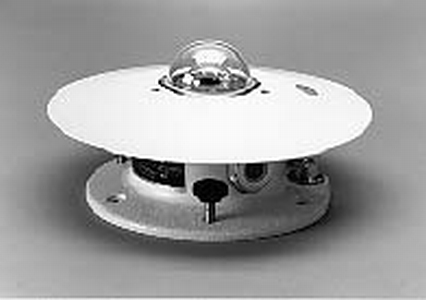A Brief Introduction to Solar Radiation and Pyranometers
NOTE: This document contains some symbols that may not
display properly in older browsers. For example, they will not display in Netscape 4.8, but they
will in InternetExplorer 6.0. If you see an ampersand followed by the text "pi" and a
semicolon here:
π
instead of the Greek lowercase letter pi, then your browser is not translating these
characters properly.
Stars generate huge amounts of energy through the process of nuclear fusion.
Our own sun, an unremarkable medium-sized star, produces a total energy E of
about 3.9x1026W. This energy is radiated into space uniformly in all directions.
Fundamental physical laws tell us that the intensity of this radiation decreases as
the inverse square of the distance from the sun. The solar constant (So) is defined
as the average energy per unit area of solar radiation falling on the surface of an
imaginary sphere of radius R around the sun:
So = E/(4π R2) = 1370 W/m2
where R is the average Earth/sun distance, about 150,000,000,000 m. The solar "constant"
actually fluctuates by a few Watts per square meter, and the energy the Earth receives varies regularly with the seasonal
change in the Earth/sun distance -- from a maximum of about
1417 W/m2 in early January to a minimum of about 1324 W/m2 six months
later. (Yes, the sun is closest to Earth in January!)
Not all of the energy that reaches the top of the Earth/atmosphere system
reaches Earth's surface. Some of it is reflected back to space and some of it is
absorbed in the atmosphere. Around noon on a typical summer day at temperate latitudes,
about 1000 W/m2 actually reaches Earth's surface. This is a lot of energy --
enough to power 10 100-W light bulbs. Currently, it is
not possible to convert even a majority of this energy into a more directly
usable form. Still, there is
great potential for solar energy to contribute to a global economy that must eventually
wean itself from its current overwhelming dependence on fossil fuels. There are already
many useful applications of solar energy, especially when it is converted directly into
electrical or heat energy.
It is not hard to measure energy from the sun at Earth's surface, a quantity called insolation.
Pyranometers (from the Greek word for fire) are designed specifically for this purpose. In high-quality
pyranometers, several devices called
thermocouples are electrically connected to form thermopiles. When sunlight
strikes
a thermopile, it creates a temperature difference across the junctions of the
thermopile. This produces a small voltage proportional to the amount of
incident energy. The advantage of thermopile-based pyranometers is that they respond
across a very broad range of wavelengths, as required to measure insolation. A
high-quality thermopile-based pyranometer is shown in Figure 1. (This instrument is
roughly 20 cm in diameter.)
 |
| Figure 1. Eppley PSP pyranometer. |
Unfortunately, accurate thermopile-based pyranometers are very expensive.
Fortunately, there is
a much less expensive alternative that also works reasonably well --
silicon-based solar cells.
Solar cells for generating electrical energy directly from sunlight are widely used.
As a result, they are very inexpensive. With careful design, it is possible to
build solar cell-based pyranometers. These might more accurately be called
"surrogate pyranometers" because they do not respond uniformly to the entire
range of radiation emitted by the sun.
Figure 2 shows a "homemade" solar cell-based pyranometer. There are two small solar cells
under the round TeflonŽ diffuser on the left of the light-colored case. (The diffuser
is about 1.9 cm in diameter.) A bubble
level for leveling the instrument is mounted on the right of the case. The output from the solar
cells drives the analong milliammeter in the dark blue case. A small commercial
solarcell-based
pyranometer is also shown. This can be used to calibrate the "homemade" pyranometer.
 |
Figure 2. A "homemade" solarcell-based pyranometer with
an analog current meter,
shown with a commercial
solar cell-based pyranometer used for calibration. |
The basic output from a pyranometer is solar energy, measured in units of Watts per square
meter. However, it is interesting to note that pyranometer output can also be used to
track the motion of clouds. This
is important to atmospheric and Earth scientists who need to understand the effects of
clouds.
Figure 3 shows insolation on 1 September, 2004, at Drexel University in Philadelphia, PA, USA, sampled
every 30 seconds. Early in the morning, skies are clear, but clouds arrive in late morning.
The variability
in insolation as a function of time, with interspersed "clear" and very low insolation
values, suggests the passage of individual cumulus clouds over the sun. Note the insolation values right
at and just after 750 minutes. Here, it appears that the insolation is actually larger than that
seen under the clear skies just before 750 minutes. This phenomenon, which is not unusual,
is due to reflection of sunlight
from the sides of clouds -- further evidence that these are well-defined cumulus clouds.
 |
| Figure 3. Insolation data showing arrival of clouds. |
You can find more information about the sun and instruments for measuring solar radiation
here. You can find instructions for building
your own solar-cell based pyranometer
here.


